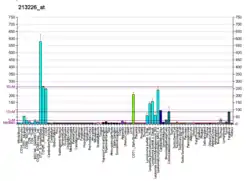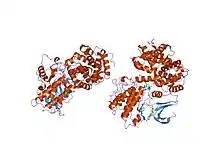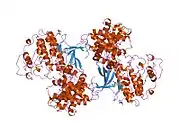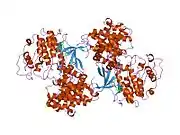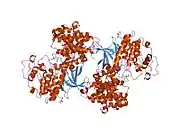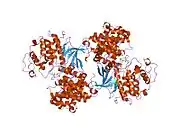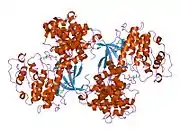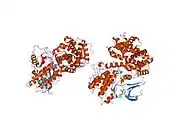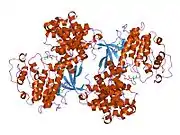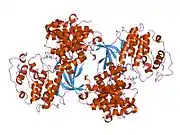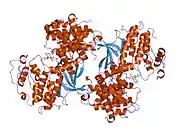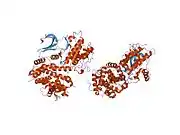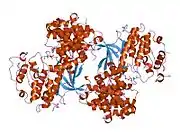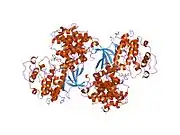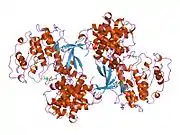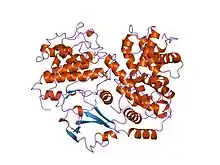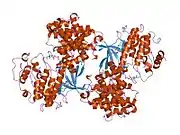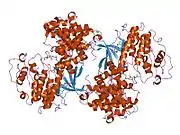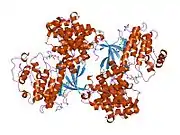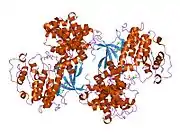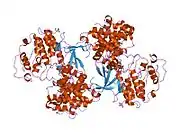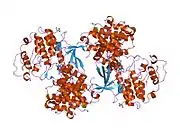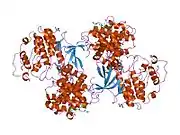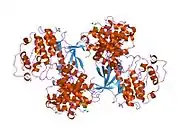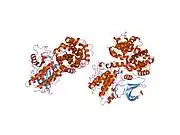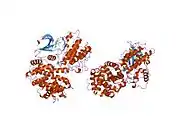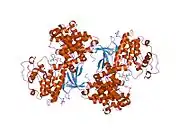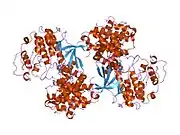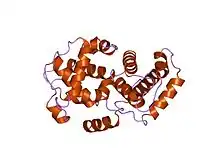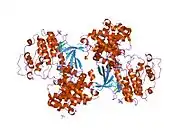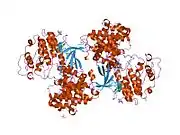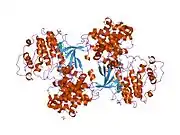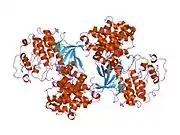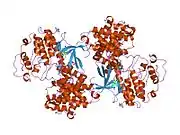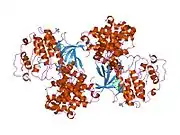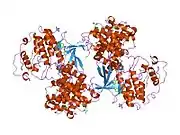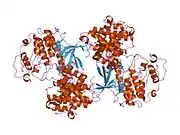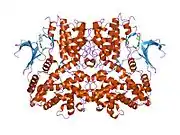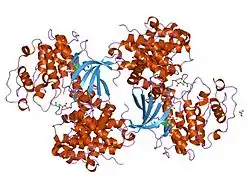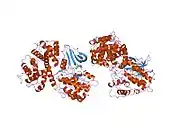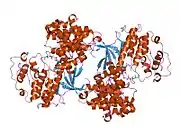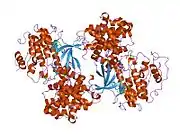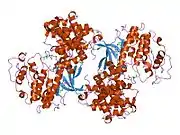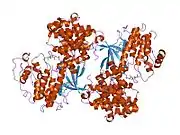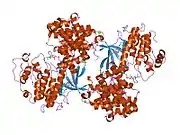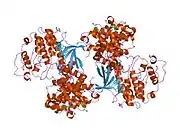Cyclin A2
Cyclin-A2 is a protein that in humans is encoded by the CCNA2 gene.[5] It is one of the two types of cyclin A: cyclin A1 is expressed during meiosis and embryogenesis while cyclin A2 is expressed in dividing somatic cells.[6]
Function
Cyclin A2 belongs to the cyclin family, whose members regulate cell cycle progression by interacting with CDK kinases. Cyclin A2 is unique in that it can activate two different CDK kinases; it binds CDK2 during S phase, and CDK1 during the transition from G2 to M phase.[7]
Cyclin A2 is synthesized at the onset of S phase and localizes to the nucleus, where the cyclin A2-CDK2 complex is implicated in the initiation and progression of DNA synthesis. Phosphorylation of CDC6 and MCM4 by the cyclin A2-CDK2 complex prevents re-replication of DNA during the cell cycle.[6]
Cyclin A2 is involved in the G2/M transition but it cannot independently form a maturation promoting factor (MPF).[8] Recent studies have shown that the cyclin A2-CDK1 complex triggers cyclin B1-CDK1 activation which results in chromatin condensation and the breakdown of the nuclear envelope.[9]
Regulation
The levels of cyclin A2 are tightly synchronized with the progression of the cell cycle.[10] Transcription initiates in late G1, peaks and plateaus in mid-S, and declines in G2.[10][6]
Cyclin A2 transcription is mostly regulated by the transcription factor E2F and begins in G1, after the R point.[10][6] Absence of cyclin A2 before the R point is due to the E2F inhibition by hypophosphorylated retinoblastoma protein (pRb). After the R point, pRb is phosphorylated and can no longer bind E2F, leading to cyclin A2 transcription.[11][12] The cyclin A2-CDK2 complex eventually phosphorylates E2F, turning off cyclin A2 transcription.[10] E2F promotes cyclin A2 transcription by de-repressing the promoter.[10][11]
Interactions
Cyclin A2 has been shown to interact with:
Clinical significance
Cyclin A2 (Ccna2) is a key protein involved in the direction of mammalian cardiac myocytes to grow and divide, and has been shown to induce cardiac repair following myocardial infarction.[21] Normally, Ccna2 is silenced postnatally in mammalian cardiac myocytes. Because of this gene silencing, adult heart muscle cells cannot divide readily to repair and regenerate after a heart attack.[21]
Ccna2 has been found to induce cardiac repair in small-animal models following myocardial infarction.[21] Preclinical trials involving injections of adenovirus which contained the Ccna2 gene into infarcted porcine (pig) hearts has shown to be protective of MI in pig hearts.[21] Ccna2 mediated cardiac repair showed both a decrease in fibrosis in the peri-infarct tissue and a greater number of cardiomyocytes at the sites of injection.[21] Delivery of Ccna2 into cardiac tissue invokes a regenerative response and markedly enhances cardiac function.[21][22][23]
Cancer
Increased expression of cyclin A2 has been observed in many types of cancer such as breast, cervical, liver, and lung among others.[6][24][25][26][27] While it is not clear whether increased expression of cyclin A2 is a cause or result of tumorigenesis, it is indicative of prognostic values such as predictions of survival or relapse.[6]
Overexpression of cyclin A2 in mammalian cells can result in the delayed onset of metaphase and anaphase.[28] It is also possible that cyclin A2-CDK contributes to tumorigenesis by the phosphorylation of oncoproteins or tumor suppressors like p53.[29]
See also
References
- GRCh38: Ensembl release 89: ENSG00000145386 - Ensembl, May 2017
- GRCm38: Ensembl release 89: ENSMUSG00000027715 - Ensembl, May 2017
- "Human PubMed Reference:". National Center for Biotechnology Information, U.S. National Library of Medicine.
- "Mouse PubMed Reference:". National Center for Biotechnology Information, U.S. National Library of Medicine.
- Paterlini P, De Mitri MS, Martin C, Münnich A, Bréchot C (July 1991). "A TaqI polymorphism in the human cyclin A gene". Nucleic Acids Res. 19 (9): 2516. doi:10.1093/nar/19.9.2516. PMC 329485. PMID 1675006.
- Yam CH, Fung TK, Poon RY (Aug 2002). "Cyclin A in cell cycle control and cancer". Cell. Mol. Life Sci. 59 (8): 1317–1326. doi:10.1007/s00018-002-8510-y. PMID 12363035. S2CID 97398.
- Pagano M, Pepperkok R, Verde F, Ansorge W, Draetta G (March 1992). "Cyclin A is required at two points in the human cell cycle". EMBO J. 11 (3): 961–971. doi:10.1002/j.1460-2075.1992.tb05135.x. PMC 556537. PMID 1312467.
- Fung TK, Ma HT, Poon RY (Mar 2007). "Specialized roles of the two mitotic cyclins in somatic cells: cyclin A as an activator of M phase-promoting factor". Mol. Biol. Cell. 18 (5): 1861–1873. doi:10.1091/mbc.E06-12-1092. PMC 1855023. PMID 17344473.
- Gong D, Ferrell JE (Sep 2010). "The roles of cyclin A2, B1, and B2 in early and late mitotic events". Mol. Biol. Cell. 21 (18): 3149–3161. doi:10.1091/mbc.E10-05-0393. PMC 2938381. PMID 20660152.
- Henglein B, Chenivesse X, Wang J, Eick D, Bréchot C (Jun 1994). "Structure and cell cycle-regulated transcription of the human cyclin A gene". Proc. Natl. Acad. Sci. U.S.A. 91 (12): 5490–5494. doi:10.1073/pnas.91.12.5490. PMC 44021. PMID 8202514.
- Woo RA, Poon RY (Jul–Aug 2003). "Cyclin-dependent kinases and S phase control in mammalian cells". Cell Cycle. 2 (4): 316–324. doi:10.4161/cc.2.4.468. PMID 12851482.
- Xu M, Sheppard KA, Peng CY, Yee AS, Piwnica-Worms H (1994). "Cyclin A/CDK2 binds directly to E2F-1 and inhibits the DNA-binding activity of E2F-1/DP-1 by phosphorylation". Mol. Cell. Biol. 14 (12): 8420–8431. doi:10.1128/MCB.14.12.8420. PMC 359381. PMID 7969176.
- Petersen BO, Lukas J, Sørensen CS, Bartek J, Helin K (January 1999). "Phosphorylation of mammalian CDC6 by cyclin A/CDK2 regulates its subcellular localization". EMBO J. 18 (2): 396–410. doi:10.1093/emboj/18.2.396. PMC 1171134. PMID 9889196.
- Saha P, Chen J, Thome KC, Lawlis SJ, Hou ZH, Hendricks M, Parvin JD, Dutta A (May 1998). "Human CDC6/Cdc18 associates with Orc1 and cyclin-cdk and is selectively eliminated from the nucleus at the onset of S phase". Mol. Cell. Biol. 18 (5): 2758–2767. doi:10.1128/mcb.18.5.2758. PMC 110655. PMID 9566895.
- Henneke G, Koundrioukoff S, Hübscher U (July 2003). "Phosphorylation of human Fen1 by cyclin-dependent kinase modulates its role in replication fork regulation". Oncogene. 22 (28): 4301–4313. doi:10.1038/sj.onc.1206606. PMID 12853968.
- Ohtoshi A, Maeda T, Higashi H, Ashizawa S, Yamada M, Hatakeyama M (January 2000). "beta3-endonexin as a novel inhibitor of cyclin A-associated kinase". Biochem. Biophys. Res. Commun. 267 (3): 947–952. doi:10.1006/bbrc.1999.2007. PMID 10673397.
- Dyson N, Dembski M, Fattaey A, Ngwu C, Ewen M, Helin K (December 1993). "Analysis of p107-associated proteins: p107 associates with a form of E2F that differs from pRB-associated E2F-1". J. Virol. 67 (12): 7641–7647. doi:10.1128/JVI.67.12.7641-7647.1993. PMC 238233. PMID 8230483.
- Joaquin M, Bessa M, Saville MK, Watson RJ (November 2002). "B-Myb overcomes a p107-mediated cell proliferation block by interacting with an N-terminal domain of p107". Oncogene. 21 (52): 7923–7932. doi:10.1038/sj.onc.1206001. PMID 12439743.
- Rosner M, Hengstschläger M (November 2004). "Tuberin binds p27 and negatively regulates its interaction with the SCF component Skp2". J. Biol. Chem. 279 (47): 48707–48715. doi:10.1074/jbc.M405528200. PMID 15355997.
- Marti A, Wirbelauer C, Scheffner M, Krek W (May 1999). "Interaction between ubiquitin-protein ligase SCFSKP2 and E2F-1 underlies the regulation of E2F-1 degradation". Nat. Cell Biol. 1 (1): 14–19. doi:10.1038/8984. PMID 10559858. S2CID 8884226.
- Shapiro SD, Ranjan AK, Kawase Y, Cheng RK, Kara RJ, Bhattacharya R, Guzman-Martinez G, Sanz J, Garcia MJ, Chaudhry HW (2014). "Cyclin A2 induces cardiac regeneration after myocardial infarction through cytokinesis of adult cardiomyocytes". Sci Transl Med. 6 (224): 224ra27. doi:10.1126/scitranslmed.3007668. PMID 24553388. S2CID 20386712.
- Woo YJ, Panlilio CM, Cheng RK, Liao GP, Suarez EE, Atluri P, Chaudhry HW (2007). "Myocardial regeneration therapy for ischemic cardiomyopathy with cyclin A2". J. Thorac. Cardiovasc. Surg. 133 (4): 927–933. doi:10.1016/j.jtcvs.2006.07.057. PMID 17382628.
- Laflamme MA, Murry CE (2011). "Heart regeneration". Nature. 473 (7347): 326–335. doi:10.1038/nature10147. PMC 4091722. PMID 21593865.
- Bukholm IR, Bukholm G, Nesland JM (Jul 2001). "Over-expression of cyclin A is highly associated with early relapse and reduced survival in patients with primary breast carcinomas". Int. J. Cancer. 93 (2): 283–287. doi:10.1002/ijc.1311. PMID 11410878. S2CID 10543682.
- Kanai M, Shiozawa T, Xin L, Nikaido T, Fujii S (May 1998). "Immunohistochemical detection of sex steroid receptors, cyclins, and cyclin-dependent kinases in the normal and neoplastic squamous epithelia of the uterine cervix". Cancer. 82 (9): 1709–1719. doi:10.1002/(sici)1097-0142(19980501)82:9<1709::aid-cncr18>3.0.co;2-8. PMID 9576293.
- Ohashi R, Gao C, Miyazaki M, Hamazaki K, Tsuji T, Inoue Y, Uemura T, Hirai R, Shimizu N, Namba M (Jan–Feb 2001). "Enhanced expression of cyclin E and cyclin A in human hepatocellular carcinomas". Anticancer Res. 21 (1B): 657–662. PMID 11299822.
- Volm M, Koomägi R, Mattern J, Stammler G (1997). "Cyclin A is associated with an unfavourable outcome in patients with non-small-cell lung carcinomas". Br. J. Cancer. 75 (12): 1774–1778. doi:10.1038/bjc.1997.302. PMC 2223613. PMID 9192980.
- den Elzen N, Pines J (Apr 2001). "Cyclin A is destroyed in prometaphase and can delay chromosome alignment and anaphase". J. Cell Biol. 153 (1): 121–136. doi:10.1083/jcb.153.1.121. PMC 2185531. PMID 11285279.
- Wang Y, Prives C (Jul 1995). "Increased and altered DNA binding of human p53 by S and G2/M but not G1 cyclin-dependent kinases". Nature. 376 (6535): 88–91. doi:10.1038/376088a0. PMID 7596441. S2CID 4240439.
Further reading
- Bailly E, Pines J, Hunter T, Bornens M (1992). "Cytoplasmic accumulation of cyclin B1 in human cells: association with a detergent-resistant compartment and with the centrosome". J. Cell Sci. 101 (3): 529–545. PMID 1387877.
- Faha B, Ewen ME, Tsai LH, Livingston DM, Harlow E (1992). "Interaction between human cyclin A and adenovirus E1A-associated p107 protein". Science. 255 (5040): 87–90. doi:10.1126/science.1532458. PMID 1532458.
- Bandara LR, Adamczewski JP, Hunt T, La Thangue NB (1991). "Cyclin A and the retinoblastoma gene product complex with a common transcription factor". Nature. 352 (6332): 249–251. doi:10.1038/352249a0. PMID 1830372. S2CID 1019851.
- Blanquet V, Wang JA, Chenivesse X, Henglein B, Garreau F, Bréchot C, Turleau C (1990). "Assignment of a human cyclin A gene to 4q26-q27". Genomics. 8 (3): 595–597. doi:10.1016/0888-7543(90)90052-V. PMID 1962755.
- Wang J, Chenivesse X, Henglein B, Bréchot C (1990). "Hepatitis B virus integration in a cyclin A gene in a hepatocellular carcinoma". Nature. 343 (6258): 555–557. doi:10.1038/343555a0. PMID 1967822. S2CID 4269638.
- Jeffrey PD, Russo AA, Polyak K, Gibbs E, Hurwitz J, Massagué J, Pavletich NP (1995). "Mechanism of CDK activation revealed by the structure of a cyclinA-CDK2 complex". Nature. 376 (6538): 313–320. doi:10.1038/376313a0. PMID 7630397. S2CID 4361179.
- Castro A, Jaumot M, Vergés M, Agell N, Bachs O (1994). "Microsomal localization of cyclin A and cdk2 in proliferating rat liver cells". Biochem. Biophys. Res. Commun. 201 (3): 1072–1078. doi:10.1006/bbrc.1994.1814. PMID 8024548.
- Dyson N, Dembski M, Fattaey A, Ngwu C, Ewen M, Helin K (1993). "Analysis of p107-associated proteins: p107 associates with a form of E2F that differs from pRB-associated E2F-1". J. Virol. 67 (12): 7641–7647. doi:10.1128/JVI.67.12.7641-7647.1993. PMC 238233. PMID 8230483.
- Li Y, Graham C, Lacy S, Duncan AM, Whyte P (1993). "The adenovirus E1A-associated 130-kD protein is encoded by a member of the retinoblastoma gene family and physically interacts with cyclins A and E". Genes Dev. 7 (12A): 2366–2377. doi:10.1101/gad.7.12a.2366. PMID 8253383.
- Lees EM, Harlow E (1993). "Sequences within the conserved cyclin box of human cyclin A are sufficient for binding to and activation of cdc2 kinase". Mol. Cell. Biol. 13 (2): 1194–1201. doi:10.1128/MCB.13.2.1194. PMC 359004. PMID 8423786.
- Sebastian B, Kakizuka A, Hunter T (1993). "Cdc25M2 activation of cyclin-dependent kinases by dephosphorylation of threonine-14 and tyrosine-15". Proc. Natl. Acad. Sci. U.S.A. 90 (8): 3521–3524. doi:10.1073/pnas.90.8.3521. PMC 46332. PMID 8475101.
- Carbonaro-Hall D, Williams R, Wu L, Warburton D, Zeichner-David M, MacDougall M, Tolo V, Hall F (1993). "G1 expression and multistage dynamics of cyclin A in human osteosarcoma cells". Oncogene. 8 (6): 1649–1659. PMID 8502485.
- Meikrantz W, Schlegel R (1996). "Suppression of apoptosis by dominant negative mutants of cyclin-dependent protein kinases". J. Biol. Chem. 271 (17): 10205–10209. doi:10.1074/jbc.271.17.10205. PMID 8626584.
- Poon RY, Jiang W, Toyoshima H, Hunter T (1996). "Cyclin-dependent kinases are inactivated by a combination of p21 and Thr-14/Tyr-15 phosphorylation after UV-induced DNA damage". J. Biol. Chem. 271 (22): 13283–13291. doi:10.1074/jbc.271.22.13283. PMID 8662825.
- Russo AA, Jeffrey PD, Patten AK, Massagué J, Pavletich NP (1996). "Crystal structure of the p27Kip1 cyclin-dependent-kinase inhibitor bound to the cyclin A-Cdk2 complex". Nature. 382 (6589): 325–331. doi:10.1038/382325a0. PMID 8684460. S2CID 4284942.
- Russo AA, Jeffrey PD, Pavletich NP (1996). "Structural basis of cyclin-dependent kinase activation by phosphorylation". Nat. Struct. Biol. 3 (8): 696–700. doi:10.1038/nsb0896-696. PMID 8756328. S2CID 383015.





